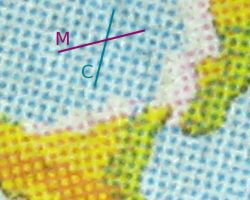Halftone
Halftone is a printing technique that simulates continuous tone imagery through the use of dots, varying either in size or in spacing, thus generating a gradient-like effect. Halftones can reproduce a wide range of colors or shades with only a limited palette of ink colors, making it a fundamental technique in monochrome and color printing. This method is particularly crucial in the reproduction of photographs and detailed artwork in newspapers, books, and magazines.
History[edit | edit source]
The halftone process was developed in the late 19th century as a way to reproduce photographs and illustrations in print media more accurately. Before the advent of halftone printing, images were often recreated by hand or through techniques that could not capture the full range of tones in a photograph. The introduction of halftone printing represented a significant advancement in the field of printmaking and graphic design, allowing for more detailed and realistic reproductions of images.
Process[edit | edit source]
The basic principle behind halftone printing involves breaking down an image into a series of dots. The density and size of these dots are varied to represent the shadows and highlights of the original image. In monochrome printing, the dots are typically larger in darker areas and smaller in lighter areas. In color printing, halftones are created for each color separation (usually cyan, magenta, yellow, and black), and the dots are printed in layers to produce a wide spectrum of colors.
Screening[edit | edit source]
The process of creating halftones is known as screening. A halftone screen, which is a grid used to break down the image into dots, can vary in its resolution, measured in lines per inch (LPI). The choice of LPI depends on the printing method and the type of paper. Higher LPI screens can reproduce more detail but require higher quality paper and printing processes.
Applications[edit | edit source]
Halftone printing is used in various applications beyond traditional print media. It is employed in the production of packaging, posters, and various types of merchandise. With advancements in digital printing technologies, halftone techniques have also evolved, allowing for more precise control over dot patterns and sizes, thus expanding the creative possibilities for artists and designers.
Digital Halftoning[edit | edit source]
In the digital realm, halftoning techniques are used to simulate continuous tone images on devices that have a binary output, such as inkjet printers, laser printers, and screens. Digital halftoning employs algorithms to manage dot placement, which can include stochastic screening, a method that randomizes dot placement to reduce visible patterning.
Challenges[edit | edit source]
Despite its widespread use, halftone printing comes with challenges. The process can introduce artifacts, such as moiré patterns, when screen angles are improperly aligned. Additionally, reproducing fine details and smooth gradients can be difficult, especially in lower quality prints.
Conclusion[edit | edit source]
Halftone printing remains a vital technique in the reproduction of images, combining the artistry of traditional printmaking with the precision of modern technology. Its ability to convey depth, texture, and color with a limited palette continues to make it indispensable in both analog and digital forms of graphic arts.
Search WikiMD
Ad.Tired of being Overweight? Try W8MD's NYC physician weight loss.
Semaglutide (Ozempic / Wegovy and Tirzepatide (Mounjaro / Zepbound) available. Call 718 946 5500.
Advertise on WikiMD
|
WikiMD's Wellness Encyclopedia |
| Let Food Be Thy Medicine Medicine Thy Food - Hippocrates |
Translate this page: - East Asian
中文,
日本,
한국어,
South Asian
हिन्दी,
தமிழ்,
తెలుగు,
Urdu,
ಕನ್ನಡ,
Southeast Asian
Indonesian,
Vietnamese,
Thai,
မြန်မာဘာသာ,
বাংলা
European
español,
Deutsch,
français,
Greek,
português do Brasil,
polski,
română,
русский,
Nederlands,
norsk,
svenska,
suomi,
Italian
Middle Eastern & African
عربى,
Turkish,
Persian,
Hebrew,
Afrikaans,
isiZulu,
Kiswahili,
Other
Bulgarian,
Hungarian,
Czech,
Swedish,
മലയാളം,
मराठी,
ਪੰਜਾਬੀ,
ગુજરાતી,
Portuguese,
Ukrainian
Medical Disclaimer: WikiMD is not a substitute for professional medical advice. The information on WikiMD is provided as an information resource only, may be incorrect, outdated or misleading, and is not to be used or relied on for any diagnostic or treatment purposes. Please consult your health care provider before making any healthcare decisions or for guidance about a specific medical condition. WikiMD expressly disclaims responsibility, and shall have no liability, for any damages, loss, injury, or liability whatsoever suffered as a result of your reliance on the information contained in this site. By visiting this site you agree to the foregoing terms and conditions, which may from time to time be changed or supplemented by WikiMD. If you do not agree to the foregoing terms and conditions, you should not enter or use this site. See full disclaimer.
Credits:Most images are courtesy of Wikimedia commons, and templates, categories Wikipedia, licensed under CC BY SA or similar.
Contributors: Prab R. Tumpati, MD





